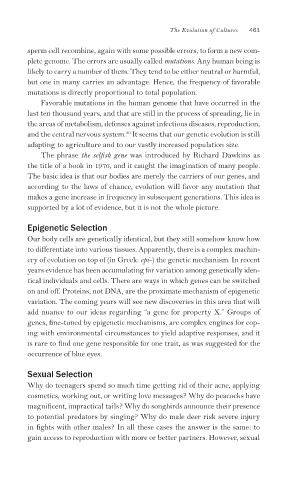Page 496 - Cultures and Organizations
P. 496
The Evolution of Cultures 461
sperm cell recombine, again with some possible errors, to form a new com-
plete genome. The errors are usually called mutations. Any human being is
likely to carry a number of them. They tend to be either neutral or harmful,
but one in many carries an advantage. Hence, the frequency of favorable
mutations is directly proportional to total population.
Favorable mutations in the human genome that have occurred in the
last ten thousand years, and that are still in the process of spreading, lie in
the areas of metabolism, defenses against infectious diseases, reproduction,
40
and the central nervous system. It seems that our genetic evolution is still
adapting to agriculture and to our vastly increased population size.
The phrase the selfi sh gene was introduced by Richard Dawkins as
the title of a book in 1976, and it caught the imagination of many people.
The basic idea is that our bodies are merely the carriers of our genes, and
according to the laws of chance, evolution will favor any mutation that
makes a gene increase in frequency in subsequent generations. This idea is
supported by a lot of evidence, but it is not the whole picture.
Epigenetic Selection
Our body cells are genetically identical, but they still somehow know how
to differentiate into various tissues. Apparently, there is a complex machin-
ery of evolution on top of (in Greek: epi-) the genetic mechanism. In recent
years evidence has been accumulating for variation among genetically iden-
tical individuals and cells. There are ways in which genes can be switched
on and off. Proteins, not DNA, are the proximate mechanism of epigenetic
variation. The coming years will see new discoveries in this area that will
add nuance to our ideas regarding “a gene for property X.” Groups of
genes, fine-tuned by epigenetic mechanisms, are complex engines for cop-
ing with environmental circumstances to yield adaptive responses, and it
is rare to find one gene responsible for one trait, as was suggested for the
occurrence of blue eyes.
Sexual Selection
Why do teenagers spend so much time getting rid of their acne, applying
cosmetics, working out, or writing love messages? Why do peacocks have
magnificent, impractical tails? Why do songbirds announce their presence
to potential predators by singing? Why do male deer risk severe injury
in fights with other males? In all these cases the answer is the same: to
gain access to reproduction with more or better partners. However, sexual

